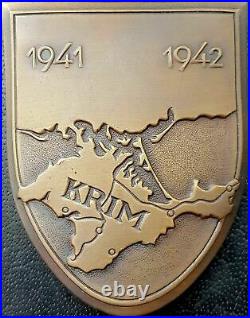
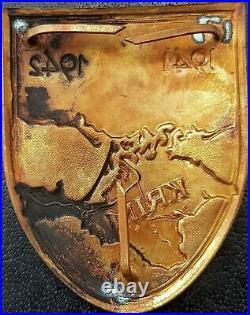
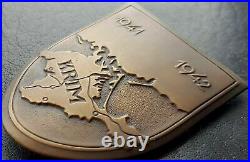
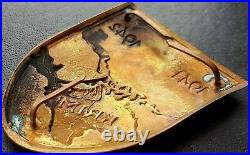
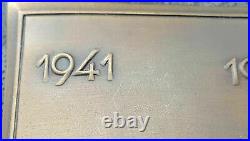
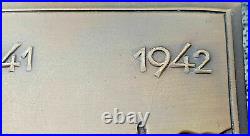
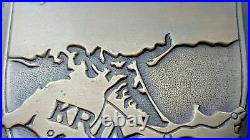
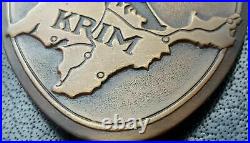
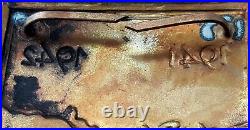
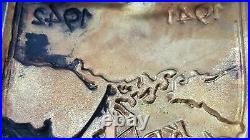
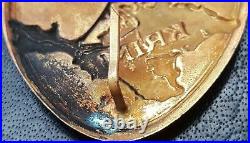
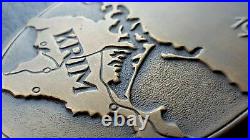
Original German Krim Shield – post WW2 / 1957 pattern – no swastika, IN PERFECT CONDITION – GENUINE ST&L (STEINHAUER UND LUECK) MADE EXAMPLE, ATTRACTIVE FINISH, THREE INTACT PRONGS, A VERY GOOD EXAMPLE OF A RARE BADGE. FEW FACTS ABOUT 1957 PATTERN AWARDS. In 1957 the West German government authorised replacement Iron Crosses with an Oak Leaf Cluster in place of the swastika, similar to the Iron Crosses of 1813, 1870, and 1914, which could be worn by World War II Iron Cross recipients. The 1957 law also authorised de-Nazified versions of most other World War II-era decorations (except those specifically associated with Nazi Party organizations, such as SS Long Service medals, or with the expansion of the German Reich, such as the medals for the annexation of Austria, the Sudetenland, and the Memel region). The main government contract to manufacture and supply these new de-nazified WW2 1957 official decorations went to the world famous German firm Steinhauer & Lueck, Luedenscheid Germany. Knights Crosses, Iron Crosses, Wound Badges, Tank Assault Badges etc were re-designed by Steinhauer & Lück – often with the oak-leaf spray replacing the swastika, with S&L having the sole patent rights to all WW2 1957 German decorations. S&L did not have the whole monopoly on medal making, other famous firms such as Deschler & Sohn, BH Maher and Juncker also manufactured these new German decorations. Lüdenscheid is situated between the cities Dortmund and Bonn. It was here that one of the youngest medal firms was founded in 1889 by August Steinhauer and Gustav Adolf Lück. The first production began in a cellar, the customer base continued to increase. A property was bought at 51 Hochstrasse which is still home for this famous company today. During WW2 Steinhauer & Lück produced medals and badges, like the famous Knights Cross and many other types of medals and badges. In 1957 this company was awarded the contract to produce all the newly re-designed legal WW2 1957 de-nazified decorations, plus the contract to manufacture all of Germany’s official decorations including Germany’s highest order the Bundesverdienstkreuz. Only a very limited number of original WW2 1957 medals are still produced, mainly Iron Crosses, German Cross Gold & Silver & Wound Badges and are considered 100% genuine by the German Government. HISTORY OF THE AWARD. The Krim Shield was instituted on July 7th, 1942, and was to commemorate the German advance into the Crimea led by General von Manstein. The award took the form of a shield with a rounded bottom. An eagle is positioned on the top, with its outstretched wings spreading across, not only the entire width of the shield, but also breaking the edges to both sides. This eagle is the standard Wehrmacht Eagle, and as such is holding in its talons a wreath with a centered swastika. The body of the shield is decorated with a map of the Crimea. The details on the map include the rivers, and six main cities in the area (denoted by a circle). The word “KRIM” is also imprinted on the map. Around the whole shield, up to the eagles’ wings, is an edge with a small intrusion, with the left side of the map protruding into this edge. The shield was affixed to the uniform via a cloth back that was held by a back plate. There were several variations on the back plate attachment method, with the most popular being four prongs on the back, two on the top and two directly below them. The cloth backing, as with all shields, matched the color of the recipients’ uniform. The award was presented to all members of the 11th German Army and the 3rd Rumanian Army that participate in the campaign. The specific criterion follows: to have served in the region for 3 months, to have taken part in at least one major combat operation, to have been wounded while serving in the region. These specifications were set up in part to prevent General Staff officers to receive the award from “official visits” to the area. Posthumous awards were made to the family of the fallen soldier accompanied by a possession certificate. As with all campaign shields the award was worn on the upper left sleeve of the uniform, and was authorized for wear on virtually every type of uniform, including the brown party uniform. It is estimated that 150,000 to 250,000 were produced and 100,000 presented. In 1957, the Krim shield was re-issued without the swastika. This item is in the category “Collectables\Militaria\World War II (1939-1945)\Medals/ Ribbons”. The seller is “a..anderson” and is located in this country: GB. This item can be shipped worldwide.
- Era: 1945-Present
- Country/ Organization: Germany
- Country/Region of Manufacture: Germany
- Theme: Militaria
- Conflict: World War II (1939-1945)
- Service: Army
- Type: Medals & Ribbons